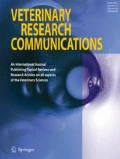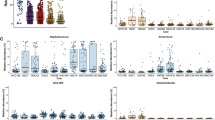Abstract
The objective of this study is to examine and compare the trends of mastitis pathogens in quarter milk samples (n = 240,232) submitted for microbiological examination at the Milk Analysis Laboratory (L.I.G.A.L.) at Galicia, Spain from June 2005 to September 2011. Autoregressive Integrated Moving Average (ARIMA) models and multivariate statistical techniques such as Cluster Analysis were used in order to detect seasonal trends and similarities between the series trends and to classify mastitis pathogens into relatively homogeneous groups. The decrease of bulk milk somatic cell counts achieved by the mastitis control program, developed in recent years in this region, is the result of the decrease in IMI caused by a limited number of mastitis pathogens. The obtained results reflect a greater complexity in the behavior of mastitis pathogens, unlike the traditional classification into contagious or environmental. Staphylococcus aureus showed a trend similar to Streptococcus dysgalactiae, a mastitis pathogen can behave in both a contagious and an environmental manner. Among the traditionally considered environmental mastitis pathogens, Strep. uberis showed a different behavior to Escherichia coli and Klebsiella pneumoniae. Coagulase-negative staphylococci (CNS) species and Streptococcus other than Strep. agalactiae showed differences in the trend model. Time-series analysis and multivariate statistical techniques, such as Cluster Analysis, could be powerful tools to assess the isolation trend of mastitis pathogens because of their ability to cope with stochastic dependence of consecutive data. Furthermore, they could be used to identify the epidemiological behavior of mastitis pathogens using the results of milk samples submitted for routine microbiological examination, by classifying them into relatively homogeneous groups.


Similar content being viewed by others
References
Aarestrup FM, Larsen HD, Jensen NE (1999) Characterization of Staphylococcus simulans strains from cases of bovine mastitis. Vet Microbiol 66:165–170
Andersen HJ, Pedersen LH, Aarestrup FM, Chriél M (2003) Evaluation of the surveillance programme of Streptococcus agalactiae in Danish dairy herds. J Dairy Sci 86:1233–1239
Barkema HW, Schukken YH, Lam TJGM, Beiboer ML, Benedictus G, Brand A (1999) Management practices associated with the incidence rate of clinical mastitis. J Dairy Sci 82:1643–1654
Box GEP, Jenkins GM (1976) Time series analysis: forecasting and control. Holden Day, San Francisco, pp 181–218
Bradley AJ (2002) Bovine mastitis: an evolving disease. Vet J 164:116–128
Bradley AJ, Leach KA, Breen JE, Green LE, Green MJ (2007) Survey of the incidence and aetiology of mastitis on dairy farms in England and Wales. Vet Rec 160:253–257
Capurro A, Aspán A, Unnerstad HR, Waller KP, Artursson K (2010) Identification of potential sources of Staphylococcus aureus mastitis problems. J Dairy Sci 93:180–191
Chan K, Ripley B (2012) TSA: time series analysis, http://cran.r-project.org/web/packages/TSA/index.html (accessed 13.06.12)
Chatzigeorgiou KS, Sergentanis TN, Tsiodras S, Hamodrakas SJ, Bagos PG (2011) Phoenix 100 versus Vitek 2 in the identification of Gram-Positive and Gram-Negative bacteria: a comprehensive meta-analysis. J Clin Microbiol 49:3284–3291
Delmas J, Chacornac JP, Robin F, Giammarinaro P, Talon R, Bonnet R (2008) Evaluation of the Vitek 2 system with a variety of Staphylococcus species. J Clin Microbiol 46:311–313
Devriese LS, de Keyser H (1980) Prevalence of different species of coagulase-negative staphylococci on teats and milk samples from dairy cows. J Dairy Res 47:155–158
Everitt BS (2005) An R and S-PLUS companion to multivariate analysis. Springer, London
Fraley C, Raftery A, Scrucca L (2012) mclust: normal mixture modeling for model-based clustering, classification, and density estimation, http://cran.r-project.org/web/packages/mclust/index.html (accessed 13.06.12)
Gillespie BE, Headrick SI, Boonyayatra S, Oliver SP (2009) Prevalence and persistence of coagulase-negative Staphylococcus species in three dairy research herds. Vet Microbiol 134:65–72
Haveri M, Hovinen M, Roslof A, Pyorala S (2008) Molecular types and genetic profiles of Staphylococcus aureus isolated from bovine intramammary infection and extramammary sites. J Clin Microbiol 46:3728–3735
Hogan JS, Smith KL (2003) Coliform mastitis. Vet Res 34:507–519
Hogan JS, Gonzalez RN, Harmon RJ, Nickerson SC, Oliver SP, Pankey JW, Smith KL (1999) Laboratory handbook on bovine mastitis. National Mastitis Council, Inc., Madison
Hyndman RJ. Forecast: forecasting functions for time series and linear models, http://cran.r-project.org/web/packages/forecast/index.html (accessed 13.06.12)
Jagielski T, Lassa H, Ahrholdt J, Malinowski E, Roesler U (2011) Genotiping of bovine Prototheca mastitis isolates from Poland. Vet Microbiol 149:283–287
Krukowski H, Lisowski A, Skòrka A (2006) Yeast and algae isolated from cows with mastitis in the Southeastern part of Poland. Pol J Vet Sci 9:181–184
Makovec JA, Ruegg PL (2003) Results of milk samples submitted for microbiological examination in Wisconsin from 1994 to 2001. J Dairy Sci 86:3466–3472
Marco JC, Rodríguez M, González M, Ziluaga I, Salazar LM, Palomino A, Méndez A, Díaz A, Fernández G (1998) Bovis nº85. Mamitis bovina y calidad de la leche (I), Etiología de las mamitis bovinas en España. Grupo Luzán 5, Madrid, pp 13–31
Matos JS, White GG, Harmon RJ, Langlois BE (1991) Isolation of Staphylococcus aureus from sites other than the lactating mammary gland. J Dairy Sci 74:1544–1549
Milne MH, Biggs AM, Barrett DC, Young FJ, Doherty S, Innocent GT, Fitzpatrick JL (2005) Treatment of persistent intramammary infections with Streptococcus uberis in dairy cows. Vet Rec 157:245–250
Munoz MA, Ahlström C, Rauch BJ, Zadoks RN (2006) Fecal shedding of Klebsiella pneumoniae by dairy cows. J Dairy Sci 89:3425–3430
Myllys V, Asplund K, Brofeldt E, Hirvelä-Koski V, Honkanen-Buzalski T, Junttila J, Kulkas L, Myllykangas O, Niskanen M, Saloniemi H, Sandholm M, Saranpää T (1998) Bovine mastitis in Finland in 1988 and 1995: changes in prevalence and antimicrobial resistance. Acta Vet Scand 39:119–126
Nam HM, Lim SK, Kang HM, Kim JM, Moon JS, Jang GC, Kim JM, Joo YS, Jung SC (2009) Prevalence and antimicrobial susceptibility of gram-negative bacteria isolated from bovine mastitis between 2003 and 2008 in Korea. J Dairy Sci 92:2020–2026
Nemeth J, Muckle CA, Gyles CL (1994) In vitro comparison of bovine mastitis and fecal Escherichia coli isolates. Vet Microbiol 40:231–238
Østerås O, Sølverød L, Reksen O (2006) Milk culture results in a large Norwegian survey-effects of season, parity, days in milk, resistance, and clustering. J Dairy Sci 89:1010–1023
Petersson-Wolfe CS, Adams S, Wolf SL, Hogan JS (2008) Genomic typing of enterococci isolated from bovine mammary glands and environmental sources. J Dairy Sci 91:615–619
Piepers S, De Meulemeester L, De Kruijff A, Opsomer G, Barkema HW, De Vliegher S (2007) Prevalence and distribution of mastitis pathogens in subclinically infected dairy cows in Flanders, Belgium. J Dairy Res 74:478–483
Piessens V, Coillie V, Verbist B, Supré K, Braem G, Van Nuffel A, De Vuyst L, Heyndrickx M, De Vliegher S (2011) Distribution of coagulase-negative Staphylococcus species from milk and environment of dairy cows differs between herds. J Dairy Sci 94:2933–2944
Piessens V, De Vliegher S, Verbist B, Braem G, Van Nuffel A, De Vuyst L, Heyndrickx M, Van Coillie E (2012) Intra-species diversity and epidemiology varies among coagulase-negative Staphylococcus species causing bovine intramammary infections. Vet Microbiol 155:62–71
Pullinger GD, Coffey TJ, Maiden MC, Leigh JA (2007) Multilocus-sequence typing analysis reveals similar populations of Streptococcus uberis are responsible for bovine intramammary infections of short and long duration. Vet Microbiol 119:194–204
Ruegg L (2009) The quest for the perfect test: phenotypic versus genotypic identification of coagulase-negative staphylococci associated with bovine mastitis. Vet Microbiol 134:15–19
Sampimon OC, Barkema HW, Berends IMGA, Sol J, Lam TJGM (2009) Prevalence and herd-level risk factors for intramammary infection with coagulase-negative staphylococci in Dutch dairy herds. Vet Microbiol 134:37–44
Sawant AA, Gillespie BE, Oliver SP (2009) Antimicrobial susceptibility of coagulase-negative Staphylococcus species isolated from bovine milk. Vet Microbiol 134:73–81
Scaccabarozzi L, Locateli C, Pisoni G, Manarolla G, Casula A, Bronzo V, Moroni P (2011) Short communication: epidemiology and genotyping of Candida rugosa strains responsable for persistent intramammary infections in dairy cows. J Dairy Sci 94:4574–4577
Shumway RH, Stoffer DS (2006) Time series analysis and its applications. With R examples. Springer, New York
Smith KL, Hogan JS (1995) Epidemiology of mamitis. In: Proceedings of The 3rd International Mamitis Seminar, Tel Aviv, Israel, pp 3–12
Sommerhäuser J, Kloppert B, Wolter W, Zschöck M, Sobiraj A, Failing K (2003) The epidemiology of Staphylococcus aureus infections from subclinical mastitis in dairy cows during a control programme. Vet Microbiol 96:91–102
Supré K, Haesebrouk F, Zadoks RN, Vaneechoutte M, Piepers S, De Vliegher S (2011) Some CNS species are affecting udder health more than others. J Dairy Sci 94:2329–2340
Taponen S, Björkroth J, Pyörälä S (2008) Coagulase-negative staphylococci isolated from bovine extramammary sites and intramammary infections in a single dairy herd. J Dairy Res 75:422–429
Tenhagen BA, Koster G, Wallmann J, Heuwieser W (2006) Prevalence of mastitis pathogens and their resistance against antimicrobial agents in dairy cows in Brandenburg, Germany. J Dairy Sci 89:2542–2551
Thorberg BM, Kuhn I, Aarestrup FM, Brandstrom B, Jonsson P, Danielsson-Tharn ML (2006) Pheno- and genotyping of Staphylococcus epidermidis isolated from bovine milk and human skin. Vet Microbiol 115:163–172
Todhunter DA, Smith KL, Hogan JS, Schoenberger PS (1991) Gram-negative bacterial infections of the mammary gland in cows. Am J Vet Res 52:184–188
Vilar-Fernández JM, González-Manteiga W (2004) Nonparametric comparison of curves with dependent errors. Stat: J Theor Appl Stat 38(2):81–99
Watts JL (1988) Etiological agents of bovine mastitis. Vet Microbiol 16:41–66
Wuertz D, Chalabi Y (2012) timeSeries: Rmetrics - financial time series objects, http://cran.r-project.org/web/packages/timeSeries/index.html (accessed 13.06.12)
Zadoks RN, Gillespie BE, Barkema HW, Sampimon OC, Oliver SP, Schukken YH (2003) Clinical, epidemiological and molecular characteristics of Streptococcus uberis infections in dairy herds. Epidemiol Infect 130:335–349
Zadoks RN, Griffiths HM, Munoz MA, Ahlstrom C, Bennett GJ, Thomas E, Schukken YH (2011a) Sources of Klebsiella and Raoultella species on dairy farms: be careful where you walk. J Dairy Sci 94:1045–1051
Zadoks RN, Middleton JR, McDougall S, Katholm J, Schukken YH (2011b) Molecular epidemiology of mastitis pathogens of dairy cattle and comparative relevance to humans. J Mammary Gland Biol Neoplasia 16:357–372
Zeger SL, Irizarry R, Peng RD (2006) On time series analsysis of public health and biomedical data. Annu Rev Public Health 27:57–79
Acknowledgments
The authors are grateful to the Galician dairy cattle producers and to the Galician veterinarians working in establishing effective mastitis control program, without whose work it would not have been possible to conduct this study, and Consolidating and Structuring Competitive Research Groups Program (CN2012/326, Xunta de Galicia).
Conflict of interest statement
None of the authors of this paper has a financial or personal relationship with other people or organisations that could inappropriately influence or bias the content of the paper.
Author information
Authors and Affiliations
Corresponding author
Rights and permissions
About this article
Cite this article
Fernández, G., Barreal, M.L., Pombo, M.B. et al. Comparison of the epidemiological behavior of mastitis pathogens by applying time-series analysis in results of milk samples submitted for microbiological examination. Vet Res Commun 37, 259–267 (2013). https://doi.org/10.1007/s11259-013-9570-1
Accepted:
Published:
Issue Date:
DOI: https://doi.org/10.1007/s11259-013-9570-1




